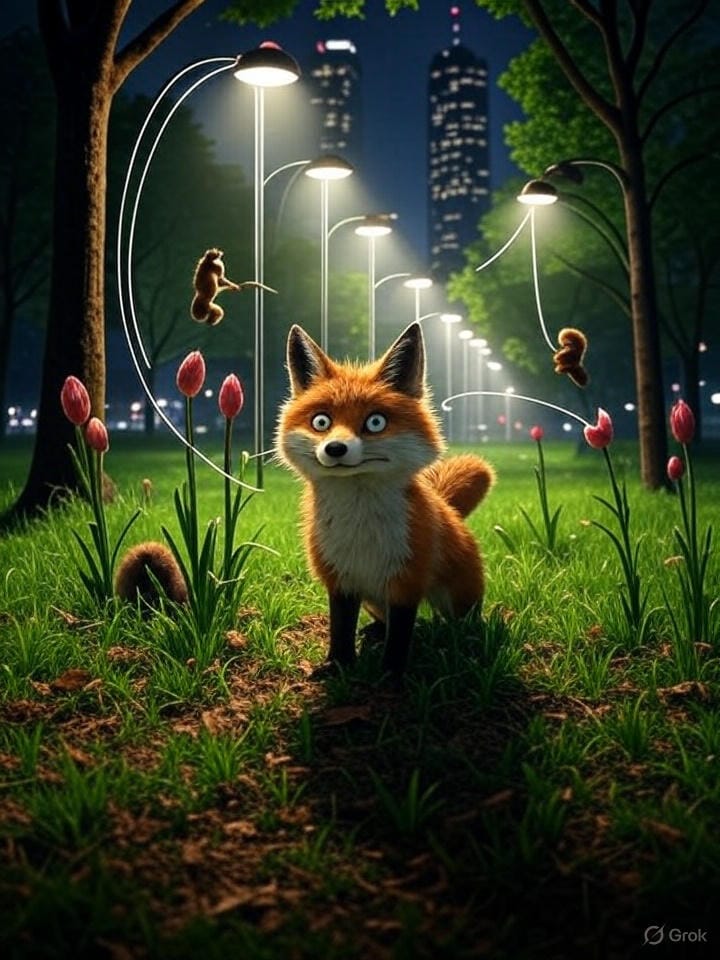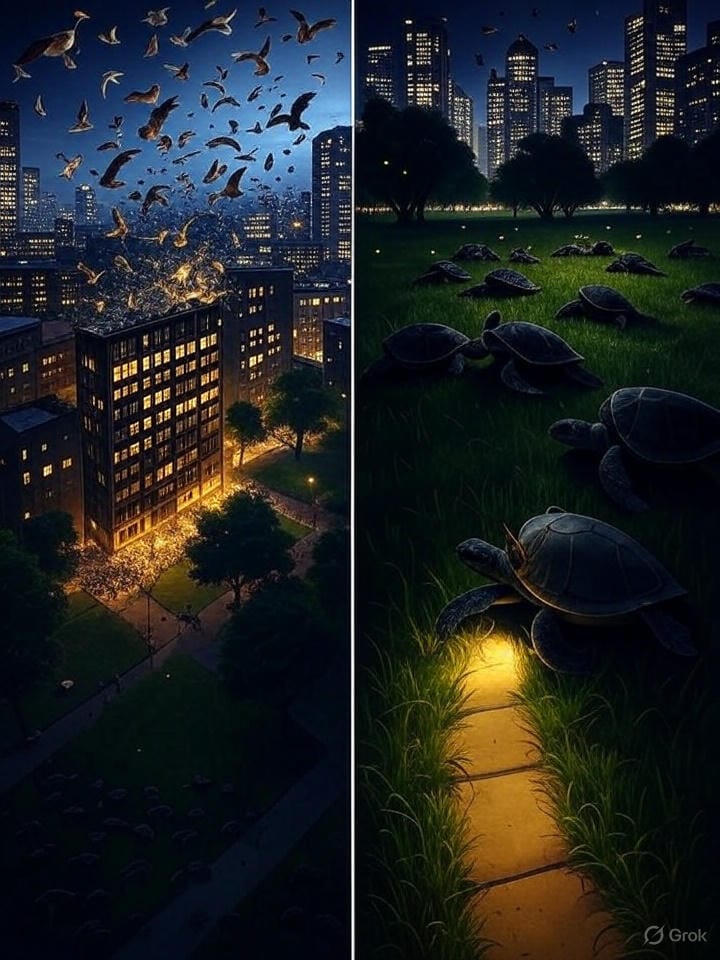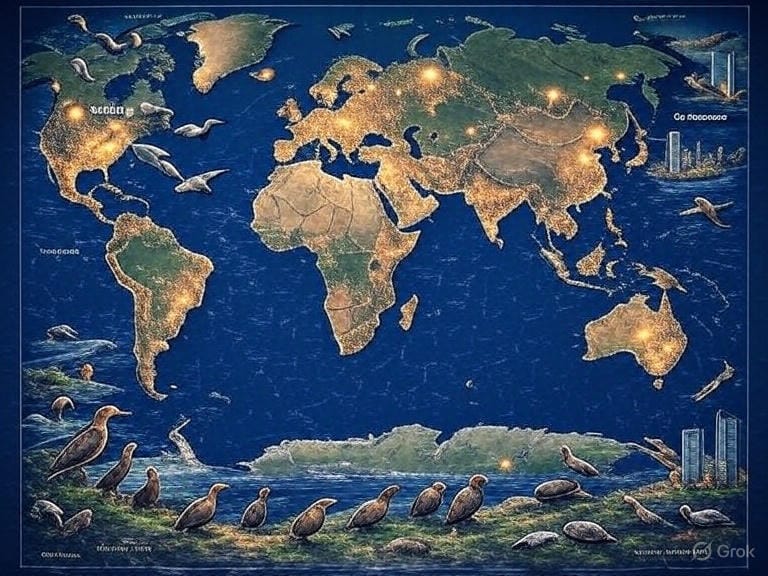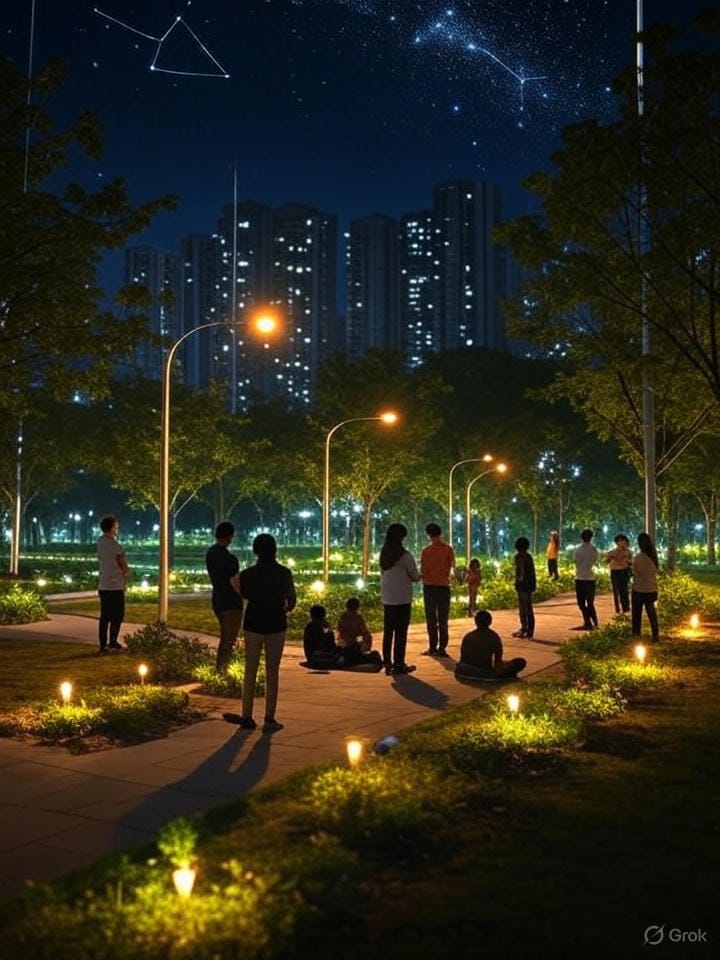
Table of Contents
ToggleWhat is light pollution Impact on biodiversity?
Our urban ecosystems face a silent crisis under the neon glow of city skies where stars vanish behind a veil of artificial light. Over 80% of people worldwide live under light-polluted skies. According to satellite data, cities like New York and London radiate visible skyglow from hundreds of kilometres away. This phenomenon is known as artificial light at night (ALAN) which disrupts the natural rhythms of wildlife. Migratory birds get crashed into illuminated skyscrapers and fireflies lose their mating signals in urban parks.
Light pollution comes from urban sources like streetlights, billboards and unshielded LEDs which emit harsh blue light that amplifies ecological harm. In cities, this problem interacts with noise and heat islands which result in more stress on biodiversity. Here’s an example: In Toronto, thousands of birds die annually from collisions with buildings. Altered light cycles disrupt pollination, predation and plant growth which threatens urban green spaces vital for sustainable cities.
This article delves into the causes of light pollution, the Impact of light pollution on urban biodiversity and real-world examples from tier 1 countries like the US, UK and Canada. By exploring innovative solutions and actionable steps we aim to show how darker skies can help in a healthier urban ecosystem.

How Light Pollution affect urban ecosystem
Alteration of Natural Light Cycles
- Circadian Rhythm Interface: ALAN overrides natural darkness. It inhibits melatonin production in wildlife. For example- urban foxes in Berlin show irregular activity patterns that lead to chronic stress and weakened immune responses.
- Seasonal Disruptions: Artificial lights hide lunar phases and seasonal shifts which delay hibernation in urban squirrels.
- Broader Hormonal Effects: Constant light in plants alters photosynthesis and growth hormones which causes urban vegetation to expend resources inefficiently.
Broader Ecological Consequences:
- Food Web Cascades: Insect deaths from light attraction reduce prey for birds and bats. This triggers top-down effects; even moths decline to 20% fewer urban bird fledglings.
- Invasive Species Proliferation: Light-favoring invasives like Asian carp in Canadian urban rivers exploit illuminated niches and displace natives by homogenising biodiversity.
- Ecosystem Service Loss: Pollination and decomposition rates are lower in some areas. And it diminishes soil fertility and carbon sequestration in urban forests.
Interactions with Other Urban Stressors
- Noise-Light Synergies: combined stressors can heighten vigilance in animals. In New York, noisy streets are compelling deer to forage less which exacerbates malnutrition.
- Heat Island Effects: Brighter areas hold more heat which makes the impact of artificial light at night stronger. For example, plants started blooming earlier than usual in Chicago’s green spaces. It has disrupted the natural cycle of pollinators.
- Air Pollution Overlap: Light pollution does not just block the stars it also makes air pollution worse by reducing visibility and also causes stress on plants. It also weakens the health and resilience of urban forests.

Light pollution Impact on biodiversity
Insects and Pollinators
Artificial lights can easily attract moths, beetles and fireflies which makes them exhausted or easy prey. In some U.S. parks, firefly numbers have fallen by 30%. Bees and other pollinators also struggle to find food at night and hurt urban farming projects. Some insects switch to daytime activity but this exposes them to new predators and upsets food chains.
Birds and Migratory Species
Bright city lights confuse migrating birds and result in collisions with deadly buildings. Toronto alone sees 1-9 million deaths each year. Light also shifts migration timing. Birds like warblers in New York miss peak insect seasons. Urban birds such as Robins, have adapted by singing at night to escape traffic noise. However this disrupts their rest and lowers breeding success.
Mammals and Nocturnal Animals
In London, bats avoid well-lit parks which cuts their feeding efficiency in half and breaks their habitats. Bright areas also expose prey organisms like rodents, making they for predators. Constant light raises stress in mammals like foxes and weakens their immune systems.
Amphibians and Reptiles
Frogs in Melbourne call less to their partners under bright lights and this leads to 20-30% fewer successful matings. In coastal Australia, sea turtle hatchlings crawl towards city lights instead of the sea and many of them eventually die. Lizards also avoid lit green spaces, as a result their habitats shrink in some places like Germany’s river corridors.
Plants and Lower Trophic Levels
Urban trees in Chicago can grow longer under artificial light but with weaker health and their early budding no longer matches pollinators’ cycles. In the UK, insects and herbivores were disturbed by altered flowering patterns. Even soil life is affected because microbes and invertebrates in Australia’s urban parks decreased decomposition and nutrient recycling.
Aquatic Life
Light pollution also affects rivers, lakes and coastal waters. Artificial light disrupts plankton movement which normally rises and sinks daily with natural light. This shift has weakened the base of aquatic food webs, affecting fish and other species. Artificial lighting along waterfronts also changes the behavior of fish, some fish avoid their feeding zones entirely.
Predator–Prey Balance at Night
ALAN changes hunting patterns for many species. For example- Owls can find their prey more easily under street lights because small mammals and insects struggle to hide themselves. This uneven advantage disrupts natural balances and can cause population crashes in prey species.
Genetic and Evolutionary Effects
Long-term exposure to artificial light may drive evolutionary changes. Some urban insects have already shown altered mating signals to cope with city lighting. Scientists across the world have warned us that this rapid adaptation could reduce genetic diversity and make populations more fragile in the long run.

Light pollution impact on biodiversity: Case studies
Developed nations with dense urban centres face light pollution that manifests in diverse ways that amplifying biodiversity loss through disrupted behaviours and habitat avoidance. There are many different types of light pollution and here are some examples from key countries to show the scale of the problem and highlight the need for the interventions of global strategies.
United States
Cities like Los Angeles highlight how artificial illumination breaks habitats into fragments for larger mammals and nocturnal species. Hunting grounds of mountain lions or cougars in bright regions are limited. Road crossing risks also arise which contribute to population isolation. Bats face more graver threats; excessive nighttime flow causes them to remain trapped inside which leads to starvation because they wait for true darkness that never comes.
Initiatives such as New York’s voluntary “Lights Out” program during migration seasons have helped in cutting bird fatalities by dimming skyscrapers and preventing disorientation. According to NOAA, exposure to artificial light at night significantly reduces the likelihood of Western Snowy Plover with probability declining sharply at illumination greater than 50 millilux and falling to 50% of peak above 100 millilux.
United Kingdom
London’s urban sprawl demonstrates impacts on smaller creatures where street-light causes nocturnal insects to go away from essential activities like mating and foraging. As a result, the population decreases which ripples through food chains. As bats are sensitive to glare, they change their flight paths or avoid feeding near illuminated areas that reduce the energy intake and reproductive success. Conservation efforts such as bad friendly lighting guidelines have aimed to shield roosts and promote directed fixes to restore natural behaviours.
Canada
Toronto has experienced severe consequences for avian species. Migratory birds are colliding with buildings at a rate that causes millions of annual deaths nationwide. Artificial sky blue pulses them off during nighttime journeys and predation. The city’s “Lights Out Toronto” campaign encourages building owners to extinguish non-essential lights in spring and fall to make a safer passage and demonstrate how community awareness can yield measurable reductions in casualties.
Other Examples across the world
In Germany, urban rivers suffer because light spills disrupt aquatic life cycles by altering fish and invertebrate rhythms in an ecosystem that is already stressed by development. In Australia, coastal zones are becoming vulnerable for marine turtles: hatchlings get attracted towards city glow instead of the ocean and as a result they face dehydration or predators.

Mitigation Strategies and Solutions
To address light pollution we need a multi-layered approach with personal responsibilities and systematic changes to safeguard our urban ecosystems. By focusing on practical steps these methods can cut biodiversity decline and also offer energy savings with enhanced nighttime safety.
First, we should start by addressing necessity: Install lights only where it is vital and avoid unnecessary glow. Our everyday actions should include the use of downward-directed fixtures to prevent skyward spill, which helps nocturnal animals navigate without interference. Incorporate timers or sensors that can activate illumination when it is needed, such as in gardens or pathways. It reduces the exposure of insects and bats.
Community can organise audits of neighbourhood lighting and identify over-bright spots to advocate for warmer-toned bulbs that emit less disruptive blue wavelengths. It will also cut energy costs by up to 20% with pollinator recovery. Lack of community support is the reason why green projects fail.
On a larger scale, urban areas in major countries can integrate dark sky policies into development codes. They should make mandatory shielded streetlights and curfews for commercial signage. Establishing protected “dark corridors” in cities preserves migration routes. These regulations, supported by EU-wide manifestos can balance human needs with wildlife protection.
Adaptive systems that adjust brightness in real-time conditions via AI sensors and other emerging technologies can minimise impact on sensitive species. Innovations in LED design prioritize amber hues over harsh whites. Pilot projects show these can restore natural behaviors (like improved bat foraging) through integrating with smart city grids for efficient resource use.
Final thoughts
Light pollution’s Impact on biodiversity is silent but a big threat. It affects ecosystems by disrupting natural behaviours across species. In tier 1 countries like the US, UK and Canada where urbanization intensifies these effects, the loss extends beyond individual animals to entire food webs. It diminishes pollination, pest control and habitat resilience.
As cities expand the urgency also grows. Unchecked illumination accelerates species decline and increases climate challenges and habitat fragmentation. However, our hope lies in proactive measures that are – smart lighting, policy reforms and community involvement. We can reclaim darker nights that foster thriving wildlife. You just have to take a step and advocate for regulations that prioritize ecological health.
FAQs
How does light pollution impact on biodiversity in cities?
Light pollution alters the natural day-night cycle on which most species depend. Insects like moths and fireflies are drawn to artificial lights and exhaust themselves or become visible prey. Birds get disoriented during migration and often collide with buildings. Even bats avoid lit- areas which reduces their feeding success.
Does light pollution impact on biodiversity in water and coastal ecosystems?
Yes. Artificial lighting along rivers, lakes and coastlines changes the movement of plankton which form the base of aquatic food webs. Fish may avoid bright waters that alter their feeding pattern. Sea turtle hatchlings are misled by city lights and move towards the city zone instead of the ocean. All these facts confirm that light pollution on biodiversity across aquatic life.
What role does light pollution play in agriculture and food security?
Pollinators like bees and beetles are vital for crop production. When artificial light disrupts their foraging or reduces their populations then only fewer plants get pollinated. Some Studies in Europe show that this leads to lower yields in community gardens and urban agriculture projects.
